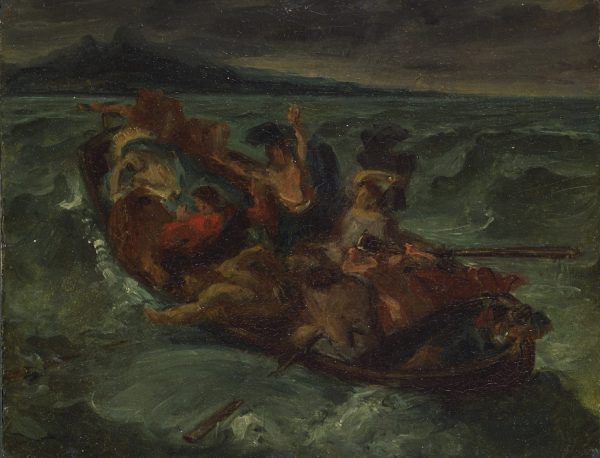Christ on the Sea of Galilee, Ca. 1853
Oil on panel., H. 0.18 m; W. 0.23 m
Deforges stamp on the reverse.
Provenance: Fernand Antonin Mercié, Paris, 1918.
Walter Pach, New York.
Anonymous sale; Parke-Bernet, New York, 6 January 1949, lot 31 (unsold).
By descent from Walter Pach to the present owner.
Delacroix was profoundly attracted by this Biblical subject showing Christ asleep during a storm on his boat, his disciples terrified in a raging sea. He referred to the subject as early as 1824-1826 in a sketchbook at the Louvre (Louvre sketchbook 1750, inv. RF 9145, quoted by Michèle Hannoosh, Eugène Delacroix: Journal, Paris, 2009, t. I, p. 1454-1455.). The painter had just enjoyed his first success with Dante and Virgil in Hell, also called The Barque of Dante, a large painting bought by the royal administration following its exhibition at the 1822 Salon.
From 1841, Delacroix began to work on the theme of Christ on the Sea of Galilee, and painted the first two pictures. He returned to the theme in 1853-1854 when he made four other versions of it. They are all quite small paintings, intended probably for friends or collectors. The most famous painting of this series is the one at the Metropolitan Museum of New York, for which our sketch could be a preparatory study.
The figures’ expressionism, the impetuous and unleashed handling, the dark and intense colours gave rise to great admiration. The Metropolitan Museum version was exhibited amongst others, at the exhibition Maîtres du Siècle, organized in April and May 1886 at Gustave Doré’s former studio in Paris. On that occasion, the painting left a lasting impression on Vincent van Gogh who mentioned it in six letters to his brother Theo and to Emile Bernard. Thus, Van Gogh wrote to Bernard on 2 June 1888: “Ah – E. DELACROIX’s beautiful painting – Christ’s boat on the sea of Galilee, he – with his pale lemon halo – sleeping, luminous – within the dramatic violet, dark blue, blood-red patch of the group of stunned disciples. On the terrifying emerald sea, rising, rising all the way up to the top of the frame.” (Van Gogh to Emile Bernard, 26 June 1888, in Fritz Erpel (éd.), Vincent van Gogh. Recueil des lettres, t. 5, Borhheim-Merten 1985, p. 261.)


